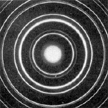fundamental? The modern atom model The scale of the atom What are we looking for? The standard model The standard model quiz
|
Waves and particles
One of the most interesting property of waves is that when two
waves pass through each other,
their effects are added together. This is called
interference.

Imagine a light source being
blocked by a sheet of metal with two slits in it. A
few meters away there is a screen. For a given point along the screen, there
are two light waves hitting the screen (one through each hole). These two
light waves travel different distances to reach the screen,
so they interfere
with each other, creating an interference pattern.
It turns out that if you carry out a similar experiment using a particle beam instead of a light source, you record a similar interference pattern. This means that all particles have wave properties. For example, here's a real interference pattern caused by an electrons scattering off gold foil:
|























 It is a very strange concept that
what we think of as solid matter particles are,
in reality, wave-like because matter
particles have wavelengths, and
can interfere with each other.
It is a very strange concept that
what we think of as solid matter particles are,
in reality, wave-like because matter
particles have wavelengths, and
can interfere with each other.